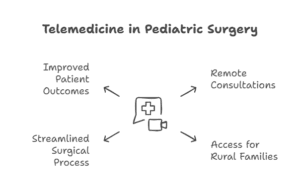On-Demand Outsourcing BPO Services for Healthcare Providers With 24/7 Coverage!
Save up to 70% on staffing costs!
Browse Specialty Staffing ServicesHow Telemedicine Is Changing the Future of Pediatric Surgery?

Telemedicine is rapidly transforming healthcare, providing innovative solutions that improve accessibility, efficiency, and patient outcomes. In the field of pediatric surgery, telemedicine is having a significant impact by enhancing pre-operative evaluations, post-operative care, and access to specialized care. It allows for virtual consultations, remote monitoring, and timely interventions, which ultimately improve the quality of care for young patients and make it easier for families to manage their children’s surgical needs.
In this article, we will explore how telemedicine is changing the future of pediatric surgery, offering a new approach to delivering care while reducing healthcare disparities and improving the patient experience.
Why Telemedicine Is Important in Pediatric Surgery
Pediatric surgery involves a wide range of specialized procedures, many of which require careful coordination and ongoing monitoring. For children in rural or underserved areas, accessing top-tier pediatric surgeons can be challenging due to limited access to healthcare facilities or specialists. Telemedicine helps overcome these barriers by providing virtual consultations, remote monitoring, and follow-up care, making it easier for families to connect with surgical experts regardless of their location.
Challenges in Pediatric Surgery:
- Limited access to pediatric specialists: Many rural areas lack specialized pediatric surgeons or facilities equipped to handle complex surgeries.
- Geographic and transportation barriers: Families living far from healthcare centers often struggle with the costs and logistics of traveling to receive care.
- Post-surgery follow-ups: In-person follow-ups can be time-consuming and burdensome for families, especially after a surgery that requires frequent monitoring.
Telemedicine offers a promising solution to these challenges, enabling children to receive quality care from the comfort of their homes.
How Telemedicine Is Revolutionizing Pediatric Surgery

1. Enhancing Pre-operative Consultations
Before undergoing surgery, patients and their families need thorough consultations to ensure the procedure is necessary and the patient is prepared. Telemedicine is improving the pre-operative process by:
- Virtual consultations: Surgeons can conduct pre-operative consultations remotely, reviewing the child’s medical history, discussing the surgery, and addressing any concerns without the need for an in-person visit.
- Faster access to specialists: Parents and caregivers can connect with pediatric surgeons more quickly, reducing waiting times for expert advice.
- Convenience for families: Virtual consultations eliminate the need for families to take time off work or school and travel long distances, making it easier for them to access the care their child needs.
2. Remote Monitoring for Post-surgery Care
Post-operative care is crucial to ensuring proper recovery, and telemedicine makes it easier to monitor young patients after surgery. Benefits of remote monitoring include:
- Monitoring vital signs: Pediatric surgeons can use telemedicine tools to remotely monitor the child’s recovery by checking vital signs, surgical site conditions, and tracking recovery progress through video calls and mobile apps.
- Reducing the need for frequent in-person visits: Families no longer need to make multiple trips to the clinic or hospital, which can be stressful and costly, especially if the family lives far from the healthcare facility.
- Timely interventions: Surgeons can identify potential complications early, such as infections or unusual symptoms, and intervene quickly to prevent more serious issues from developing.
3. Improving Access to Pediatric Surgical Specialists
Access to specialized care is a common challenge for families in rural areas. Telemedicine allows families to consult with pediatric surgical specialists without the need to travel to large medical centers. Key benefits include:
- Remote expert opinions: Families can connect with top pediatric surgeons for second opinions or consultations on complex surgical cases, ensuring that they receive the best possible care.
- Minimized delays: Children in underserved or rural areas can receive timely surgical consultations and scheduling without waiting weeks for an in-person appointment.
- Enhanced communication: Telemedicine platforms allow for continuous communication between patients, families, and medical teams, ensuring that the family is fully informed throughout the process.
4. Supporting Complex Surgical Cases
Pediatric surgery often involves complex procedures that require the expertise of multiple specialists. Telemedicine helps facilitate collaboration between different healthcare professionals to ensure the child receives the best possible care. How telemedicine supports complex cases:
- Multidisciplinary collaboration: Surgeons, anesthesiologists, pediatricians, and other specialists can collaborate virtually to discuss the surgery, plan the procedure, and monitor recovery.
- Case reviews and consultations: Telemedicine allows for real-time consultations with surgical teams, ensuring that the patient receives expert care and that all necessary specialists are involved in the process.
- Improved outcomes: By facilitating collaboration and timely interventions, telemedicine can lead to better surgical outcomes and faster recovery for children.
5. Reducing Healthcare Disparities
In many areas, access to pediatric surgeons and specialized healthcare services is limited, especially in low-income or rural communities. Telemedicine plays a crucial role in reducing healthcare disparities by:
- Making care more accessible: Families no longer need to travel long distances or relocate temporarily to access specialized pediatric care. Telemedicine allows families in underserved areas to access high-quality pediatric surgical services without the logistical and financial burdens of travel.
- Offering affordable care options: Telemedicine consultations are often more affordable than in-person visits, reducing the financial barriers to accessing pediatric surgery.
6. Enhancing Family Engagement
Pediatric surgery often involves significant emotional and logistical challenges for families. Telemedicine helps keep families engaged in the care process by:
- Easing concerns: Virtual consultations allow parents to ask questions and receive answers from their healthcare provider in real time, reducing anxiety about the surgery.
- Involving the family in recovery: Through video consultations, parents can be actively involved in the post-operative care process, helping them monitor the child’s condition and ensuring proper recovery at home.
7. Telemedicine for Global Access to Pediatric Surgery
Telemedicine extends beyond local borders, offering international access to pediatric surgery. Families can connect with world-class surgeons and healthcare providers from anywhere in the world, ensuring that children with complex conditions can receive specialized care regardless of their location.
Conclusion
Telemedicine is playing a transformative role in the field of pediatric surgery by improving access to care, reducing logistical barriers, enhancing patient outcomes, and making surgery more convenient for families. By enabling virtual consultations, remote monitoring, and expert collaboration, telemedicine is making pediatric surgery more accessible and efficient. As technology continues to evolve, the role of telemedicine in pediatric surgery will only grow, further enhancing the delivery of care and improving health outcomes for children.
What People Are Asking
1. How does telemedicine improve access to pediatric surgery?
Telemedicine allows families, especially those in rural areas, to access pediatric surgeons virtually, reducing the need for long travel and improving timely care.
2. Can telemedicine replace in-person visits for pediatric surgery?
Telemedicine can complement in-person visits by offering pre-operative consultations, post-surgery monitoring, and follow-up care, but complex surgeries still require in-person treatment.
3. How does telemedicine help with pediatric surgery recovery?
Telemedicine allows for remote monitoring, which helps healthcare providers track the recovery process and address complications early, reducing the need for frequent in-person visits.
4. Is telemedicine effective for complex pediatric surgeries?
Yes, telemedicine facilitates multidisciplinary collaboration and expert consultations, improving the management and outcomes of complex pediatric surgeries.
5. What are the benefits of telemedicine for pediatric surgeons?
Telemedicine allows pediatric surgeons to reach more patients, consult with specialists, and monitor post-operative care, improving the quality of care and patient outcomes.
Disclaimer
For informational purposes only; not applicable to specific situations.
For tailored support and professional services,
please contact Staffingly, Inc. at (800) 489-5877
Email: support@staffingly.com.
About This Blog: This Blog is brought to you by Staffingly, Inc., a trusted name in healthcare outsourcing. The team of skilled healthcare specialists and content creators is dedicated to improving the quality and efficiency of healthcare services. The team passionate about sharing knowledge through insightful articles, blogs, and other educational resources.
 Book a Demo to Build Your Team Today!
Book a Demo to Build Your Team Today!
 Read Case Studies
Read Case Studies 



 Virtual Medical Assistants
Virtual Medical Assistants



